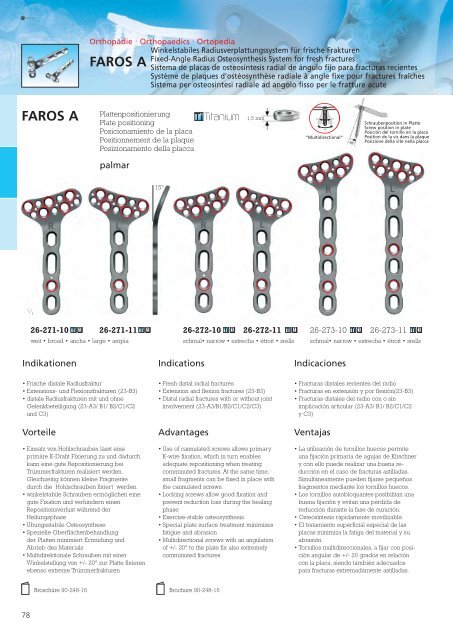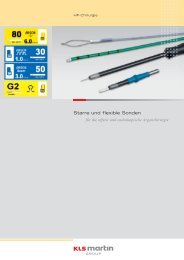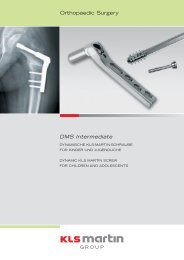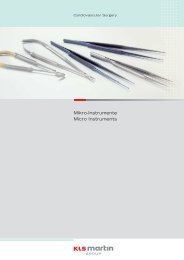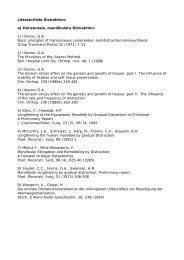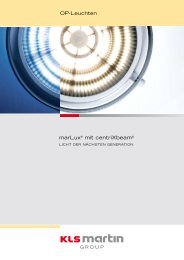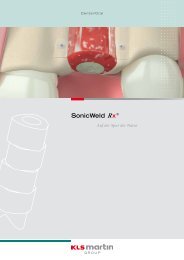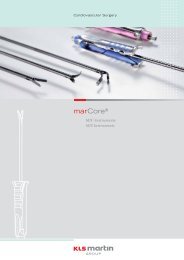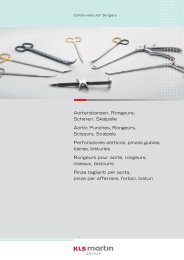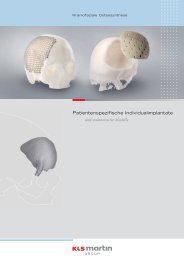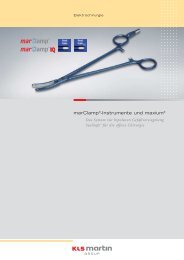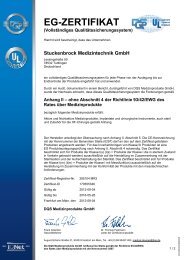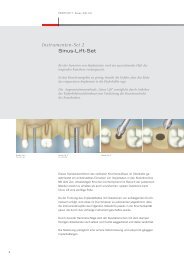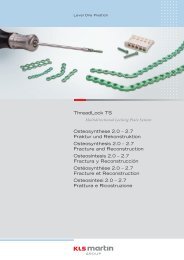- Page 1:
Orthopaedics Spezial-Katalog Specia
- Page 4 and 5:
Übersicht Titan-Schrauben Overview
- Page 6 and 7:
II Ti Ti Schraubenübersicht Screw
- Page 8 and 9:
IV Schrauben-Grundset Basic screw s
- Page 11 and 12:
VII
- Page 13 and 14:
Orthopädie . Orthopaedics . Ortope
- Page 15:
Obere Extremität Upper extremity E
- Page 18 and 19:
4 Osteosynthese . Osteosynthesis .
- Page 20 and 21:
6 Modularität System Osteosynthese
- Page 22 and 23:
8 Osteosynthese . Osteosynthesis .
- Page 24 and 25:
10 Micromodul 1,0 mm Micro module 1
- Page 26 and 27:
12 Osteosynthese . Osteosynthesis .
- Page 28 and 29:
0.6 mm 14 1 ⁄1 1 ⁄1 Osteosynthe
- Page 30 and 31:
16 Osteosynthese . Osteosynthesis .
- Page 32 and 33:
18 1 ⁄1 0.6 mm Osteosynthese . Os
- Page 34 and 35:
im Instrumentenset in instrument ra
- Page 36 and 37:
22 Osteosynthese . Osteosynthesis .
- Page 38 and 39:
1 ⁄1 26-110-20 24 1.0 mm 1 Osteos
- Page 40 and 41:
im Instrumentenset in instrument ra
- Page 42 and 43: 28 Osteosynthese . Osteosynthesis .
- Page 44 and 45: 30 1 ⁄1 1.2 mm Osteosynthese . Os
- Page 46 and 47: im Instrumentenset in instrument ra
- Page 48 and 49: 34 Osteosynthese . Osteosynthesis .
- Page 50 and 51: 1 ⁄1 1 ⁄1 36 0.6 mm Osteosynthe
- Page 52 and 53: 38 Osteosynthese . Osteosynthesis .
- Page 54 and 55: 40 Osteosynthese . Osteosynthesis .
- Page 56 and 57: 1.0 mm 42 1 ⁄1 1 ⁄1 1.2 mm 1
- Page 58 and 59: 26-111-06 26-111-85 26-111-60 26-11
- Page 60 and 61: 46 Osteosynthese . Osteosynthesis .
- Page 62 and 63: Indikationen Verlängerung des Daum
- Page 64 and 65: 50 Osteosynthese . Osteosynthesis .
- Page 66 and 67: 52 1 ⁄1 Osteosynthese . Osteosynt
- Page 68 and 69: Indikationen 54 Osteosynthese . Ost
- Page 70 and 71: Indications 56 Osteosynthese . Oste
- Page 72 and 73: Ti 58 Osteosynthese . Osteosynthesi
- Page 74 and 75: 1 ⁄2 26-350-00 12,5 cm/ 4 3 ⁄4"
- Page 76 and 77: 1 ⁄2 26-350-02 11,5 cm/ 4 1 ⁄2"
- Page 78 and 79: 1 ⁄2 26-350-11 10 cm/ 3 3 ⁄4" H
- Page 80 and 81: 66 3,2 mm 1,5 mm 2,5 mm Osteosynthe
- Page 82 and 83: Indikationen 68 Benettfraktur Radiu
- Page 84 and 85: 70 Osteosynthese . Osteosynthesis .
- Page 86 and 87: 72 Ti Selbstschneidend Self-tapping
- Page 88 and 89: 74 1 ⁄2 26-351-00 St 10 Ø 1,0 mm
- Page 90 and 91: 76 1 ⁄2 26-451-00 Ø 1,6 mm / 150
- Page 94 and 95: 80 Orthopädie . Orthopaedics . Ort
- Page 96 and 97: Ti Selbstschneidend & kanüliert Se
- Page 98 and 99: 84 Orthopädie . Orthopaedics . Ort
- Page 100 and 101: 86 1 ⁄2 1 ⁄2 26-276-19 Ø 1,9 m
- Page 102 and 103: 88 Osteosynthese . Osteosynthesis .
- Page 104 and 105: Ti 90 Osteosynthese . Osteosynthesi
- Page 106 and 107: 92 1 ⁄1 1 ⁄1 26-171-10 rechts r
- Page 108 and 109: 94 1 ⁄2 1 ⁄2 Osteosynthese . Os
- Page 110 and 111: 96 1 ⁄2 1 ⁄2 26-185-35 Ø 3,5 m
- Page 112 and 113: Präoperative Situation: Ulnavarian
- Page 114 and 115: Osteosynthese . Osteosynthesis . Os
- Page 116 and 117: 102 1 ⁄1 1 ⁄1 Osteosynthese . O
- Page 118 and 119: 3,0 mm Distanz/Distance/Distancia/
- Page 120 and 121: Ti ACP BCP CCP 106 Indikation AC Lu
- Page 122 and 123: 26-502-12-50 26-504-12-50 26-901-08
- Page 124 and 125: 110 1 ⁄2 Osteosynthese . Osteosyn
- Page 126 and 127: 1 ⁄2 26-185-20 16 cm/6 1 ⁄4 " S
- Page 128 and 129: 1 ⁄2 114 Verbrugge 23-757-01 17,5
- Page 130 and 131: 116 Osteosynthese . Osteosynthesis
- Page 132 and 133: 118
- Page 134 and 135: Indikationen: ● Revision bei unbe
- Page 136 and 137: 122 Prothetik . Prosthetics . Prot
- Page 138 and 139: Ti 26-210-01 klein small pequeño p
- Page 140 and 141: 126 1 ⁄2 Prothetik . Prosthetics
- Page 142 and 143:
128 1 ⁄2 Prothetik . Prosthetics
- Page 144 and 145:
130 Probe-Köpfe, sphärisch Trial
- Page 146 and 147:
132
- Page 148 and 149:
Vickers Handhalter ● Schnelles un
- Page 150 and 151:
136 1 ⁄1 10-130-05 massiv, mit cm
- Page 152 and 153:
1 ⁄2 1 ⁄2 138 1 ⁄1 Metzenbaum
- Page 154 and 155:
140 1 ⁄2 1 ⁄2 Weichteilinstrume
- Page 156 and 157:
1 ⁄2 Adson-Brown 142 1 ⁄1 12-24
- Page 158 and 159:
Ti 1 ⁄2 144 Diethrich 1 ⁄2 Weic
- Page 160 and 161:
Ti 146 1 ⁄2 1 ⁄2 scharf sharp a
- Page 162 and 163:
148 1 ⁄2 Vickers Low Profile 15-7
- Page 164 and 165:
150 Weichteilinstrumente . Soft Tis
- Page 166 and 167:
1 ⁄1 1 ⁄2 1 ⁄2 152 Steinmann
- Page 168 and 169:
154 Weichteilinstrumente . Soft Tis
- Page 170 and 171:
156 Mikroinstrumente . Micro Instru
- Page 172 and 173:
158 Spitzen tips puntas pointes pun
- Page 174 and 175:
160 Spitzen tips puntas pointes pun
- Page 176 and 177:
162 1 ⁄2 1 ⁄2 Gregory 20-612-18
- Page 178 and 179:
164 1 ⁄2 1 ⁄2 1 ⁄1 Mini-Lexer
- Page 180 and 181:
166 1 ⁄2 Knocheninstrumente . Bon
- Page 182 and 183:
168 1 ⁄2 Vickers 1 ⁄2 Williger
- Page 184 and 185:
170 1 ⁄2 Knocheninstrumente . Bon
- Page 186 and 187:
172 23-777-90 1 ⁄2 ⁄2 Stellbrin
- Page 188 and 189:
174 1 ⁄2 1 ⁄1 Knocheninstrument
- Page 190 and 191:
23-970-91 176 1 ⁄2 23-973-02 Säg
- Page 192 and 193:
17-400-95 178 17-400-91 Martin-Vigo
- Page 194 and 195:
55-442-15 MicroStop ® -Container 6
- Page 196 and 197:
182
- Page 198 and 199:
25-100-01 184 Orthopädie . Orthopa
- Page 200 and 201:
186 Gesamtlänge Total length Largo
- Page 202 and 203:
8,0 mm 188 3,5 mm Gesamtlänge Tota
- Page 204 and 205:
H 25-100-02 190 L Grundset . Basic
- Page 206 and 207:
12 mm 192 3,8 mm Gesamtlänge Total
- Page 208 and 209:
194 16 mm 4,8 mm Gesamtlänge Total
- Page 210 and 211:
1 ⁄2 196 Gesamtlänge Total lengt
- Page 212 and 213:
198 1 ⁄2 Indikation: zur Abstütz
- Page 214 and 215:
1 ⁄2 200 25-140-46 links left izq
- Page 216 and 217:
25-100-03 202 Orthopädie . Orthopa
- Page 218 and 219:
204 1 ⁄2 1 ⁄2 Orthopädie . Ort
- Page 220 and 221:
206 Orthopädie . Orthopaedics . Or
- Page 222 and 223:
1 ⁄2 25-221-15 18,5 cm/7 1 ⁄2"
- Page 224 and 225:
25-120-00 210 Orthopädie . Orthopa
- Page 226 and 227:
25-120-00 212 Orthopädie . Orthopa
- Page 228 and 229:
7,0 mm 25-119-98 214 4,2 mm Gesamtl
- Page 230 and 231:
216 Teilgewinde Partial thread Rosc
- Page 232 and 233:
für Spongiosaschrauben Ø 3,5 mm f
- Page 234 and 235:
220 1 mm 10 mm rechtwinklig right-a
- Page 236 and 237:
222 1 ⁄2 6 mm Orthopädie . Ortho
- Page 238 and 239:
mit AO-Ansatz with AO attachment co
- Page 240 and 241:
1 ⁄2 226 30 mm 30 mm Orthopädie
- Page 242 and 243:
25-110-00 228 Orthopädie . Orthopa
- Page 244 and 245:
25-110-00 230 Orthopädie . Orthopa
- Page 246 and 247:
232 Gesamtlänge Total length Largo
- Page 248 and 249:
234 Gesamtlänge Total length Largo
- Page 250 and 251:
236 1,2 mm 15 mm 25-142-31 32 mm li
- Page 252 and 253:
8 mm 8 mm 238 2 mm 2,5 mm 8 mm 12 m
- Page 254 and 255:
mit AO-Ansatz with AO-attachment co
- Page 256 and 257:
1 ⁄2 242 25-212-15 10,5 cm/4 1
- Page 258 and 259:
25-600-00 244 Orthopädie . Orthopa
- Page 260 and 261:
25-600-00 246 Orthopädie . Orthopa
- Page 262 and 263:
248 Gesamtlänge Total length Largo
- Page 264 and 265:
1 ⁄2 25-622-10 = 100 mm 25-622-15
- Page 266 and 267:
25-200-00 252 Orthopädie . Orthopa
- Page 268 and 269:
Kirschner Trokarspitze Trocar, poin
- Page 270 and 271:
256 1 ⁄2 Orthopädie . Orthopaedi
- Page 272 and 273:
258 1 ⁄2 1 ⁄1 Orthopädie . Ort
- Page 274 and 275:
260 ca. 1 ⁄2 Orthopädie . Orthop
- Page 276 and 277:
262 Spiralbohrer Twist drill Brocas
- Page 278 and 279:
264 bis until hasta jusqu'à fino a
- Page 280 and 281:
266 1 ⁄2 Orthopädie . Orthopaedi
- Page 282 and 283:
268 Orthopädie . Orthopaedics . Or
- Page 284 and 285:
270 1 ⁄3 Orthopädie . Orthopaedi
- Page 286 and 287:
272 Orthopädie . Orthopaedics . Or
- Page 288 and 289:
26-500-10 274 Orthopädie . Orthopa
- Page 290 and 291:
1 ⁄1 1 ⁄1 276 26-585-05 Obertei
- Page 292 and 293:
1 ⁄1 1 ⁄1 1 ⁄1 Orthopädie .
- Page 294 and 295:
1 ⁄2 280 25-211-44 Handgriff für
- Page 296 and 297:
26-500-50 282 Orthopädie . Orthopa
- Page 298 and 299:
26-500-60 284 Orthopädie . Orthopa
- Page 300 and 301:
Ti 286 11,5 cm Orthopädie . Orthop
- Page 302 and 303:
288
- Page 304 and 305:
290 Knie und Hüfte . Knee and Hip
- Page 306 and 307:
Kirschner mit 3 Zughaken with 3 tra
- Page 308 and 309:
294 16 mm mit Nut grooved con ranur
- Page 310 and 311:
296 16 mm 16 mm 6,5 mm 6,5 mm Knie
- Page 312 and 313:
298 16 mm mit Nut grooved con ranur
- Page 314 and 315:
300 16 mm mit Nut grooved con ranur
- Page 316 and 317:
302 16 mm mit Nut grooved con ranur
- Page 318 and 319:
4,5 mm 4,8 mm 304 11,5 mm 14 mm Kni
- Page 320 and 321:
25-300-00 306 Knie und Hüfte . Kne
- Page 322 and 323:
308 1 ⁄2 25-222-43 Bohrbüchse f.
- Page 324 and 325:
1 ⁄2 25-232-15 27 cm/10 1 ⁄2" E
- Page 326 and 327:
312 1 ⁄2 1 ⁄2 für Kinder for c
- Page 328 and 329:
Vorteile: 314 Knie und Hüfte . Kne
- Page 330 and 331:
Bis zu 10 Platten und 10 Schrauben
- Page 332 and 333:
Winkelstellung 85° - 145° Angle a
- Page 334 and 335:
320 Tragschrauben Lag Screws Tornil
- Page 336 and 337:
322 25-238-06 21,5 cm/8 1 ⁄2" D.M
- Page 338 and 339:
1 ⁄2 324 Knie und Hüfte . Knee a
- Page 340 and 341:
326 Knie und Hüfte . Knee and Hip
- Page 342 and 343:
328
- Page 344 and 345:
330 T-Drive 2,7 mm Fußchirurgie .
- Page 346 and 347:
Ti 332 Fußchirurgie . Foot surgery
- Page 348 and 349:
Ti 334 Fußchirurgie . Foot surgery
- Page 350 and 351:
Ti Rückfuß Hindfoot Talón Pied p
- Page 352 and 353:
338 1 ⁄2 26-930-20 2,0/2,5 mm Sch
- Page 354 and 355:
1 ⁄2 340 1 ⁄2 Fußchirurgie . F
- Page 356 and 357:
342 Fußchirurgie . Foot surgery .
- Page 358 and 359:
Ti 344 Fußchirurgie . Foot surgery
- Page 360 and 361:
1 ⁄2 26-351-00 12,5 cm/ 4 3 ⁄4"
- Page 362 and 363:
Indikationen Benettfraktur Radiusk
- Page 364 and 365:
350 Fußchirurgie . Foot surgery .
- Page 366 and 367:
352 1 ⁄1 10-100-04 13,5 cm / 5 1
- Page 368 and 369:
354 1 ⁄2 1 ⁄2 Adson Mixter-Baby
- Page 370 and 371:
1 ⁄2 356 1 ⁄1 15-093-14 16 cm /
- Page 372 and 373:
358 Hackstock 1 ⁄2 1 ⁄2 Fußchi
- Page 374 and 375:
1 ⁄2 360 Williger 1 ⁄2 1 ⁄1 2
- Page 376 and 377:
362 1 ⁄2 26-990-10 17,5 cm / 7" F
- Page 378 and 379:
364
- Page 380 and 381:
Nummernindex Numerical Index Indice
- Page 382 and 383:
Nummernindex Numerical Index Indice
- Page 384 and 385:
Nummernindex Numerical Index Indice
- Page 386 and 387:
Nummernindex Numerical Index Indice
- Page 388 and 389:
Nummernindex Numerical Index Indice
- Page 390 and 391:
Nummernindex Numerical Index Indice
- Page 392 and 393:
Index, alphabetisch Deutsch A Acrom
- Page 394 and 395:
Index, alphabetisch Deutsch J Jacob
- Page 396 and 397:
382 Alphabetical Index English A Ac
- Page 398 and 399:
Alphabetical Index English K Kern -
- Page 400 and 401:
Índice, alfabético Español A Agu
- Page 402 and 403:
388 Índice, alfabético Español L
- Page 404 and 405:
390 Index alphabétique Français A
- Page 406 and 407:
Index alphabétique Français Levie
- Page 408 and 409:
Indice, alfabetico Italiano A Adatt
- Page 410 and 411:
396 Indice, alfabetico Italiano Mar
- Page 412 and 413:
Übersicht Stahl-Schrauben Overview
- Page 414:
400


